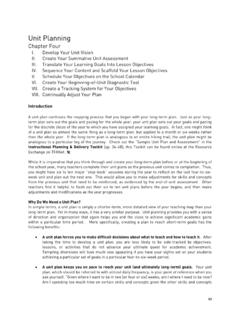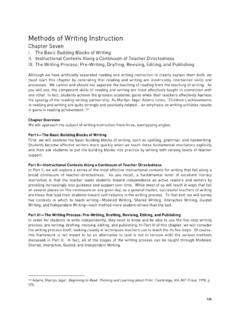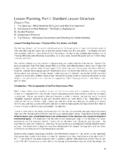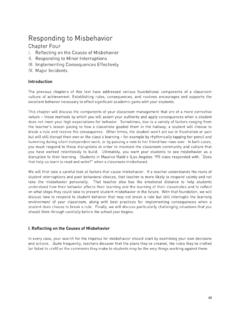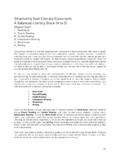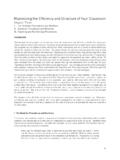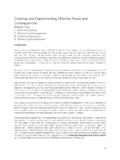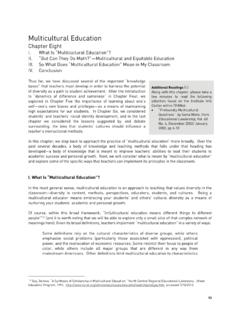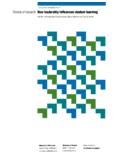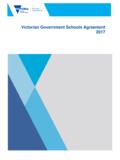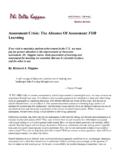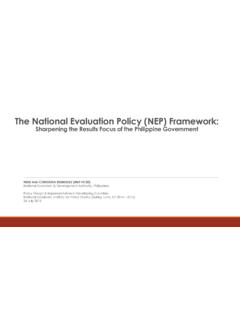Transcription of The Power of High Expectations: Closing the Gap in …
1 The Power of high expectations : Closing the Gap in Your Classroom Chapter Two I. high expectations : A Teacher's Primary Role in Closing the Achievement Gap II. But What Do high expectations Actually Look Like? III. The Power of high expectations Students' Perspective IV. Conclusion: high expectations for You and Your Students In the previous chapter, we surveyed some of the many reported causes of the achievement gap. Racism, inequitable funding, poverty, lack of political Power , school structures, family structures, group culture . all are often blamed for the fact that your students in your classroom are academically behind where they should be. Taken all at once and in such a grand scope, these many causes can be overwhelming. And yet, as thousands of corps Additional Readings.
2 Members and millions of dedicated teachers before you have Along with this chapter, please read the proven, it is well within your Power to overcome one of the following selections found on the Institute most potent and insidious factors perpetuating the Info Center within TFANet: achievement gap in this country the pattern of low Racism, Discrimination, and expectations of Students'. expectations that has been placed on our students because of Achievement from Affirming their race and class. That is, our students are bombarded with Diversity: The Sociopolitical Context of messages and images from grand but intangible forces like Multicultural Education the media and from more familiar and trusted entities such as Equity Within Reach: Insights from individual teachers or family members that reinforce the idea the Front Lines of America's that students in the communities where we are working cannot Achievement Gap, results of a survey achieve at the same level as students in other schools and of Teach For America corps members communities.
3 Moreover, our students have often internalized these messages so that they, in essence, have low expectations of themselves. As teachers of students who are living under the burden of these lowered expectations , we have a special responsibility to fight such lowered expectations in ourselves and in others. I. high expectations : A Teacher's Primary Role in Closing the Achievement Gap In your lifetime and career, no matter what direction it takes, we hope that you will work to combat some of those big, systemic factors that are holding back minority and low-income students in this country. During your initial two-year commitment to your students, however, you may find it challenging enough to focus on all of the issues in your classroom, and tackling some of those broader forces may seem out of reach.
4 The good news is that you can tackle and overcome the achievement gap in your classroom for your students. A key to that success will be establishing and maintaining high expectations of your students. 29. The Power of high expectations In the Teaching As leadership book, you are introduced to six principles that inevitably characterize the approach of Taking on every probable challenge and teachers who lead their children to significant academic dilemma that comes with the task of being a teacher is not necessarily proactive or gains. We suggest that by modeling your own practice on necessary, rather providing ALL your students those four principles, you too will essentially close the with the concrete real-life experiences and achievement gap for your students in your classroom.
5 As high expectations for learning are the you read that book, you undoubtedly noticed the central essential keys for creating an environment importance of high expectations . where anything is possible. Viewed through the lens of high expectations , successful Reid Whitaker, Houston 02. teachers in low-income communities are those who: Director, Online K-12 Curriculum Initatives (1) Establish an ambitious academic goal for what their students' will accomplish that some may believe to be unreasonable. In establishing those goals, teachers must look beyond traditional expectations of their students and instead benchmark their students' learning against the achievement of students in the most successful classrooms in the most successful schools in the country. Given your students' potential to achieve, why should they be deprived of learning at the rate and level of students in affluent communities?
6 (2) Invest students in achieving the ambitious academic goal. This investment process involves convincing your students that those big goals are possible. As discussed below, in doing so you harness the amazing Power of the self-fulfilling prophecy of high expectations students work harder and achieve more, simply because they believe they can and are expected to. (3) Work purposefully and relentlessly to achieve their goal overcoming all obstacles. As an effective teacher, you will assume full responsibility for moving your students forward to meet their ambitious academic goals. Given the many unique obstacles your students may face, whether because of inequitable school resources or the challenges of poverty, determination to ensure students fulfill their true potential requires an unusual level of purposefulness and determination.
7 (4) Deliberately and continually improve performance over time through a constant process of self-evaluation and learning. As part of teachers' ongoing reflection process, they must work hard to combat the constant negative influences of messages of lowered expectations that eat away at their and their students' visions of academic achievement. The Self-Fulfilling Prophecy of Low expectations Redux So, a central tenet of this focus on high expectations is the idea that low, or high , expectations are a self- fulfilling prophecy. While this concept is discussed in Teaching As leadership , the central relevance of this concept to our discussion of the causes of the achievement gap (and the sheer importance of this research) makes it worth revisiting here. The dramatic positive and negative impacts of expectations are well established by education research.
8 As education researcher and sociologist Sonia Nieto (whose work you will read along with this chapter). explains: 30. The term self-fulfilling prophecy, coined by Merton in 1948, means that students perform in ways in which teachers expect. Their performance is based on subtle and sometimes not so subtle messages from teachers about students' worth, intelligence, and capability. The term did not come into wide use until 1968, when the classic study by Rosenthal and Jacobson provided the impetus for subsequent extensive research on the subject. In this study, several classes of children in grades one through six were given a nonverbal intelligence test (the researchers called it the Harvard Test of Influenced Acquisition ), which researchers claimed would measure the students' potential for intellectual growth.
9 Twenty percent of the students were randomly selected by the researchers as intellectual bloomers, and their names were given to the teachers. Although their test scores actually had nothing at all to do with their potential, the teachers were told to be on the alert for signs of intellectual growth among these particular children. Overall these children, particularly in the lower grades, showed considerably greater gains in IQ. during the school year than did the other students. They were also rated by their teachers as being more interesting, curious, and happy, and thought to be more likely to succeed later in Because the teachers THOUGHT the students would be successful, the students WERE My first year, the paperwork I inherited was such a mess successful. The importance of this research that it wasn't until the third week of school that I finally had and was able to read all of my students IEPs.
10 When I read cannot be understated. These results verify the Antoine's goals Antoine had proven himself to be a incredible positive Power of simply expecting the helpful, outgoing student -- I actually cried. A third- most out of our students. They also highlight grader, Antoine was supposed to learn to recognize and the monumental potential for academic success identify the letters of the alphabet and the numbers 1-20. I. that is lost when we succumb to common cried, because I was afraid of the idea that this might assumptions about the limits of students' actually be an appropriate goal for him. Luckily, however, I. abilities. didn't change my opinion that the student I was beginning to know just seemed capable of so much more. By the end And, we are learning that teachers' faith in of the year, Antoine was performing long addition and subtraction with regrouping and reading on a mid-first- students' success is a particularly important grade level.
